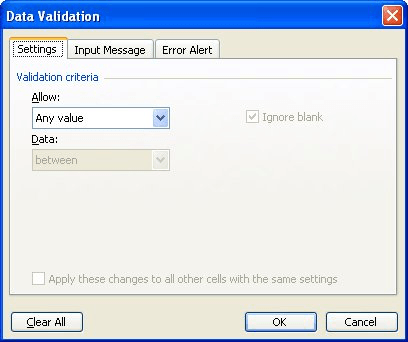Please Note: This article is written for users of the following Microsoft Excel versions: 97, 2000, 2002, and 2003. If you are using a later version (Excel 2007 or later), this tip may not work for you. For a version of this tip written specifically for later versions of Excel, click here: Limiting the Number of Characters in a Cell.
Written by Allen Wyatt (last updated February 8, 2020)
This tip applies to Excel 97, 2000, 2002, and 2003
Chris has a need to limit the number of characters that can be typed into a cell. For example, he needs to limit the input to no more than 20 characters per cell, whether they are typed or pasted into the cell. If the user tries to put in more than 20 characters, then they need to be alerted and the input disallowed. Chris wonders how he can enforce such a limitation.
Excel's Data Validation feature has a built-in way to check for the length of whatever is being entered into a cell. All you need to do is select the cell you want to limit and follow these steps:

Figure 1. The Data Validation dialog box.
This works fine if you are entering text into a cell, but it can be a little funky if someone is entering a numeric value. (This may not be a real problem, as entering more than 20 digits as a number is a very unusual circumstance in Excel.)
It also is a problem if you want to make sure that pasted information is checked for its length; pasting something into a cell that uses Data Validation eliminates the Data Validation on the cell. In that case you'll want to use a macro to do the length checking. You can find such a solution already at ExcelTips, in a tip entitled Setting a Length Limit on Cells. (You can search for this tip title using the search box at the upper-right of any page.)
ExcelTips is your source for cost-effective Microsoft Excel training. This tip (12328) applies to Microsoft Excel 97, 2000, 2002, and 2003. You can find a version of this tip for the ribbon interface of Excel (Excel 2007 and later) here: Limiting the Number of Characters in a Cell.

Excel Smarts for Beginners! Featuring the friendly and trusted For Dummies style, this popular guide shows beginners how to get up and running with Excel while also helping more experienced users get comfortable with the newest features. Check out Excel 2019 For Dummies today!
Need to modify how a cell reference, in a formula, is constructed? The shortcut described in this tip will help you step ...
Discover MoreSometimes you have too much information in a cell and you need to "pare down" what is there to get to the info you really ...
Discover MoreGot a worksheet in which there may be entire columns that are duplicates of each other? If you want to delete those ...
Discover MoreFREE SERVICE: Get tips like this every week in ExcelTips, a free productivity newsletter. Enter your address and click "Subscribe."
There are currently no comments for this tip. (Be the first to leave your comment—just use the simple form above!)
Got a version of Excel that uses the menu interface (Excel 97, Excel 2000, Excel 2002, or Excel 2003)? This site is for you! If you use a later version of Excel, visit our ExcelTips site focusing on the ribbon interface.
FREE SERVICE: Get tips like this every week in ExcelTips, a free productivity newsletter. Enter your address and click "Subscribe."
Copyright © 2025 Sharon Parq Associates, Inc.
Comments